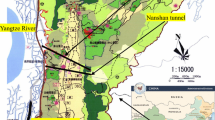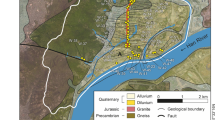Abstract
The Hsueh-Shan tunnel is the fifth longest road tunnel in the world. During the excavation, the tunnel encountered several events of groundwater inrush, causing serious delay of the construction. Data on groundwater discharge to the tunnel were gathered from the monitoring system and their spatial and temporal variations were analyzed. The results of the integrated analysis of groundwater discharge and local precipitation indicated that the discharge increased rapidly when the cumulative rainfall exceeded 85 mm. The groundwater level recession rate after a rainfall event was found to be independent of rainfall intensity. A hydrogeological conceptual model was developed to simulate the long-term groundwater discharge to the tunnel. Sensitivity analysis was first conducted to identify sensitive parameters, and then the calibration process was accomplished by the automated parameter estimation method. The calibrated model was then used to evaluate the potential impact of tunnel excavation on the Feitsui reservoir; the average percentage loss of inflow to the Feitsui reservoir from 2006 to 2010 is estimated to be 1.74 %. The developed model can provide a tool for evaluating the regional hydrogeologic setting and the influence of tunnel construction on water resources.
Résumé
Le tunnel Hsueh-Shan est le cinquième plus long tunnel routier dans le monde. Durant le percement, le tunnel a rencontré plusieurs arrivées d’eau, évènements causant des délais sérieux de construction. Des données sur le débit de nappe vers le tunnel ont été collectées depuis le système de surveillance et leurs variations spatiales et temporelles analysées. Les résultats de l’analyse intégrée du débit de nappe et des précipitations locales indiquent que le débit augmente rapidement quand la précipitation cumulée excède 85 mm. On a trouvé que le taux de diminution du niveau de la nappe après un événement pluvieux est indépendante de l’intensité de la précipitation. Un modèle hydrogéologique conceptuel a été développé pour simuler à long terme le débit de nappe dans le tunnel. Une analyse de sensibilité a d’abord été conduite pour identifier les paramètres sensibles, puis le calage a été effectué par la méthode d’estimation paramétrique automatisée. Le modèle calé a alors été utilisé pour évaluer l’impact potentiel de l’excavation du tunnel sur le réservoir Feitsui; la pourcentage moyen de perte de flux entrant dans le réservoir Feitsui de 2006 à 2010 est estimé à 1.74 %. Le modèle développé peut fournir un outil pour préciser le cadre hydrogéologique régional et pour évaluer l’influence de la construction du tunnel sur les ressources en eau.
Resumen
El túnel Hsueh-Shan es el quinto túnel de carretero de mayor longitud en el mundo. Durante la excavación, el túnel se enfrentó con varios eventos de irrupción de agua subterránea, lo cual causó serios retrasos en la construcción. Los datos sobre la descarga de agua subterránea al túnel fueron reunidos mediante un sistema de monitoreo y se analizaron sus variaciones temporales y espaciales. Los resultados de los análisis integrados de la descarga de agua subterránea y la precipitación local indicaron que la descarga se incrementaba rápidamente cuando la lluvia acumulada excedía los 85 mm. Se encontró que la tasa de recesión del nivel de agua subterránea después de un evento de lluvia era independiente de la intensidad de la lluvia. Se desarrolló un modelo hidrogeológico conceptual para simular a largo plazo la descarga de agua subterránea hacia el túnel. El análisis de sensibilidad fue primero llevado a cabo para identificar los parámetros sensibles, y luego el proceso de calibración fue cumplimentado por el método de estimación automática de parámetros. El modelo calibrado fue luego usado para evaluar el impacto potencial de la excavación del túnel en el embalse Feitsui; el promedio de la pérdida porcentual de la entrada al embalse Feitsui desde 2006 a 2010 se estimó en 1.74 %. El modelo desarrollado puede proporcionar una herramienta para evaluar el marco hidrogeológico regional y la influencia de la construcción del túnel sobre los recursos de agua.
摘要
雪山隧道是世界第五长的公路隧道。在开挖的过程中,隧道遇到了几次地下水突水事件,导致了严重的建设延期。监测系统收集了地下水向隧道排泄的数据,本文对排泄的时空变化进行了分析。对地下水排泄和当地降水的综合分析的表明,当累积降雨量达到85 mm时,地下水的排泄量迅速增加。另外还发现,在一个降雨事件后,地下水的退水速率与降雨强度无关。文中建立了一个水文地质概念模型,模拟了地下水对隧道的长期排泄。首先进行了敏感性分析,确定了敏感参数,然后利用自动参数估计法完成了校正过程。校正后的模型可以用来评估隧道开挖对Feitsui含水层的潜在影响;据估计从2006年到2010年,Feitsui含水层的补给水量损失平均百分比估计为1.74 %。文中所建立的模型可以为评估区域水文地质条件和隧道建设对水资源的影响提供一种工具。
Resumo
O túnel de Hsueh-Shan é o quinto túnel rodoviário mais longo em todo o mundo. Durante a escavação foram encontrados vários eventos de irrupção de águas subterrâneas, causando graves atrasos na construção. Os dados sobre a afluência de água subterrânea ao túnel foram recolhidos a partir do sistema de monitorização, tendo sido analisadas as suas variações espaciais e temporais. Os resultados da análise integrada da descarga de águas subterrâneas e da precipitação local indicaram que a descarga aumentava rapidamente quando a precipitação cumulativa excedia os 85 mm. O coeficiente de recessão do nível das águas subterrâneas, após um evento de precipitação, foi considerado independente da intensidade da chuvada. Foi desenvolvido um modelo hidrogeológico concetual para simular a descarga de longo prazo das águas subterrâneas para o túnel. A análise de sensibilidade foi inicialmente conduzida para identificar parâmetros sensíveis e, em seguida, o processo de calibração foi realizado pelo método automático de estimação do parâmetro. O modelo calibrado foi então usado para avaliar o potencial do impacte da escavação do túnel na albufeira da barragem Feitsui; a percentagem média de perda de afluxo para a albufeira da barragem Feitsui, de 2006 até 2010, é estimada em 1.74 %. O modelo desenvolvido pode fornecer uma ferramenta para avaliar a configuração hidrogeológica regional e a influência da construção do túnel sobre os recursos hídricos.












Similar content being viewed by others
References
Attanayake PM, Waterman MK (2006) Identifying environmental impacts of underground construction. Hydrogeol J 14(7):1160–1170
Bear J (1993) Modeling flow and contaminant transport in fractured rocks. Academic, San Diego
Berkowitz B (1994) Modeling flow and contaminant transport in fractured media, chap 6. Adv Porous Media 2:397–451
Carrera J, Herediaet J, Vomvoris S, Hufschmied P (1990) Fractured flow modeling: application of automatic calibration techniques to a small fractured monzonitic gneiss block. In: Neumann SP, Neretneiks I (eds) Hydrogeology of low permeability environments. IAH selected papers, vol 2. Heise, Hannover, Germany, pp 115–167
Chisyaki T (1984) A study of confined flow of ground water through a tunnel. Ground Water 22(2):162–167
Doherty J (2005) PEST: model-independent parameter estimation, user manual, 5th edn. Watermark Numerical Computing, Brisbane, Australia, 336 pp
El Tani M (2003) Circular tunnel in a semi-infinite aquifer. Tunn Undergr Space Technol 18(1):49–55
Fernandez G, Moon J (2010a) Excavation-induced hydraulic conductivity reduction around a tunnel, part 1: guideline for estimate of ground water inflow rate. Tunn Undergr Space Technol 25(5):560–566
Fernandez G, Moon J (2010b) Excavation-induced hydraulic conductivity reduction around a tunnel, part 2: verification of proposed method using numerical modeling. Tunn Undergr Space Technol 25(5):567–574
Goodman RE, Moye DG, Van Chalkwyk A, Javandel I (1965) Groundwater inflows during tunnel driving. Eng Geol 2:39–56
Harbaugh AW (1990) A computer program for calculating subregional water budgets using results from the U.S. Geological Survey modular three-dimensional ground-water flow model: US Geol Surv Open-File Rep 90–392, 46 pp
Harbaugh AW (2005) MODFLOW-2005, the U.S. Geological Survey modular ground-water model: the ground-water flow process. US Geol Surv Tech Methods 6-A16, 253 pp
Hill M (1998) Method and guidelines for effective model calibration. US Geol Surv Water-Resour Invest Rep 98-4005, 90 pp
Huang HH, Shyu JBH, Wu YM, Chang CH (2012) Seismotectonics of northeastern Taiwan: kinematics of the transition from waning collision to subduction and postcollisional extension. J Geophys Res-Soil Earth 117. doi:10.1029/2011JB008852
Hwang J-H, Lu C-C (2007) A semi-analytical method for analyzing the tunnel water inflow. Tunn Undergr Space Technol 22(1):39–46
Kitterod NO, Colleuille H, Wong WK, Pedersen TS (2000) Simulation of groundwater drainage into a tunnel in fractured rock and numerical analysis of leakage remediation, Remeriksporten tunnel, Norway. Hydrogeol J 8:480–493
Lei S (1999) An analytic solutions for steady flow into a tunnel. Ground Water 37(1):23–26
Li H, Kagami H (1997) Groundwater level and chemistry changes resulting from tunnel construction near Matsumoto City, Japan. Environ Geol 31(1–2):76–84
Marquardt DW (1963) An algorithm for least-squares estimation of nonlinear parameters. J Soc Ind Appl Math 11(2):431–441
Meiri D (1985) Unconfined groundwater flow calculation into a tunnel. J Hydrol 82:69–75
Molinero J, Samper J, Juanes R (2002) Numerical modeling of the transient hydrogeological response produced by tunnel construction in fractured bedrocks. Eng Geol 64:369–386
Perrochet P (2005) Confined flow into a tunnel during progressive drilling: an analytical solution. Ground Water 43(6):943–946
Shimojima E, Tanaka T, Yoshioka R, Hoso Y (1993) Seepage into a mountain tunnel and rain infiltration. J Hydrol 147:121–151
Taiwan Area National Expressway Engineering Bureau (1991) Geological investigation final report for Pinlin-Tauchen section at basic design stage of National Taipei-Ilan Expressway. Taiwan Area National Expressway Engineering Bureau, Taiwan
Teng LS (1996) Extensional collapse of the northern Taiwan mountain belt. Geology 24:949–952. doi:10.1130/0091-7631(1996) 024<0949:ECOTNT>2.3.CO;2
Tsai YB, Feng CC, Chiu JM, Liaw HB (1975) Correlation between microearthquakes and geological faults in the Hsuntuen-Ilan area. Pet Geol Taiwan 12:149–167
Tsai FT-C, Sun N-Z, Yeh WW-G (2003) A combinatorial optimization scheme for parameter structure identification in groundwater modeling. Ground Water 41(2):156–169
Yang FR, Lee CH, Kung WJ, Yeh HF (2009) The impact of tunneling construction on the hydrogeological environment of “Tseng-Wen Reservoir Transbasin Diversion Project” in Taiwan. Eng Geol 103(1–2):39–58
Yeh WW-G, Yoon YS (1981) Aquifer parameter identification with optimum dimension in parameterization. Water Resour Res 17(3):664–672
Yeh Y-H, Lin C-H, Rocker SW (1989) A study of upper crustal structures beneath northeastern Taiwan: possible evidence of the western extension of Okinawa Trough. Proc Geol Soc China 32:139–156
Acknowledgements
This material is based on the work supported by National Science Council (NSC) under award NSC-98-3114-E-002-013-. The data supported by Dr. Tszeng at the TANEEB and Sinotech Engineering Consultants, Ltd. is gratefully acknowledged. The authors wish to thank Kenneth Bell, David Hartwell, Lloyd W. Young, Jr.. Ahmed Fawzy Yousef, and one anonymous reviewer for their reviews and constructive comments.
Author information
Authors and Affiliations
Corresponding author
Electronic supplementary material
Below is the link to the electronic supplementary material.
ESM 1
(PDF 15 kb)
Rights and permissions
About this article
Cite this article
Chiu, YC., Chia, Y. The impact of groundwater discharge to the Hsueh-Shan tunnel on the water resources in northern Taiwan. Hydrogeol J 20, 1599–1611 (2012). https://doi.org/10.1007/s10040-012-0895-6
Received:
Accepted:
Published:
Issue Date:
DOI: https://doi.org/10.1007/s10040-012-0895-6




